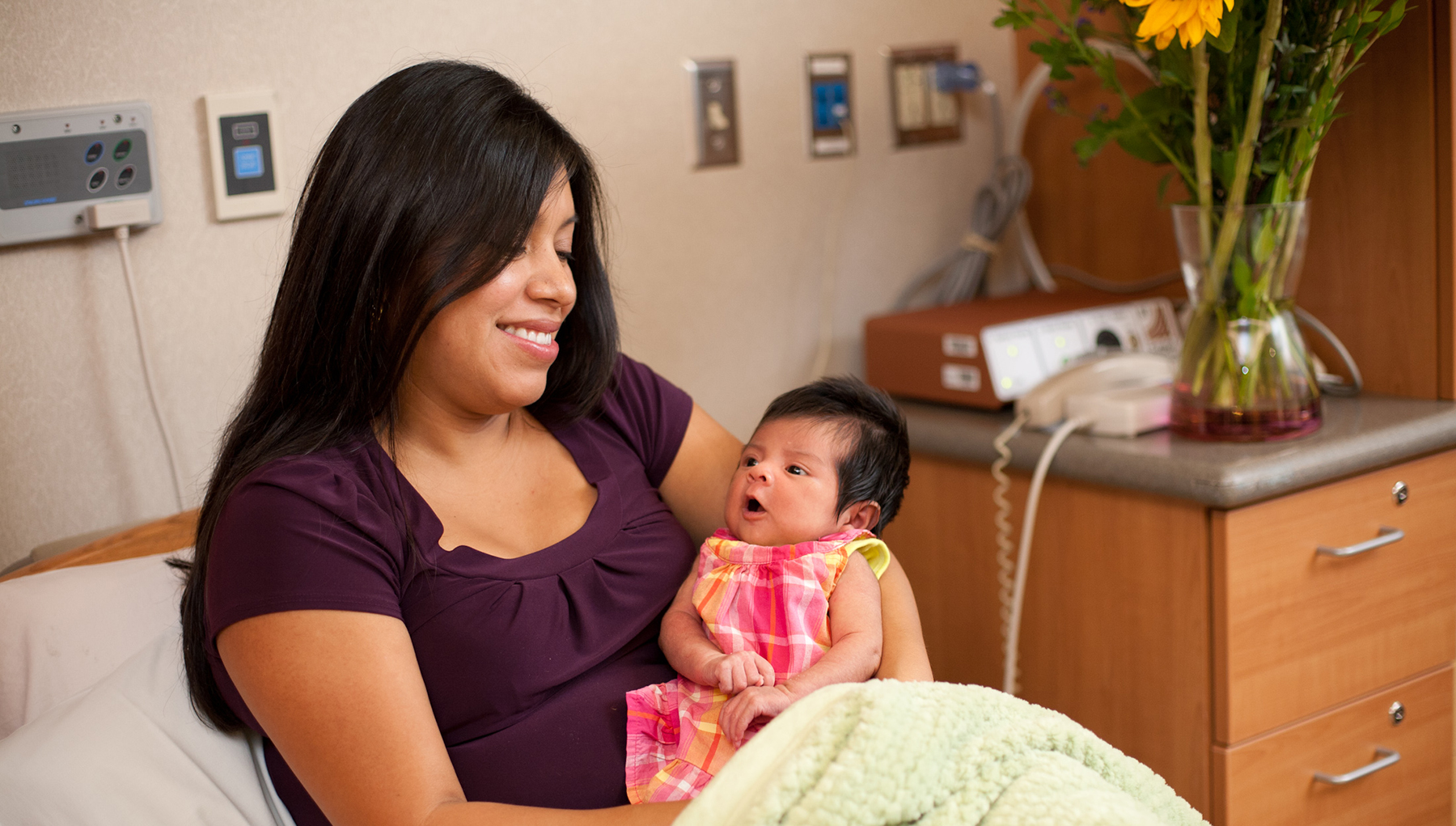From conception through the full 40 weeks of pregnancy (or longer!), your body and the baby-to-be will go through many changes. Some changes will be very noticeable but many will happen inside, without any noticeable symptoms.
Pregnancy is divided into three-month segments called trimesters:
- First trimester: Weeks 1-12
- Second trimester: Weeks 13-26
- Third trimester: Week 27-delivery (around 40 weeks)
Each trimester brings specific milestones for you and the baby. Your UNM Women's Health provider will be by your side through every passing week. During each trimester, you will get different types of prenatal care (health care during pregnancy).
Let's take a look at what to expect each month of pregnancy—for the baby, your body and your prenatal care.
Trimester 1
Month 1
Weeks: 1-4
Prepare for a lot of pregnancy education at your first prenatal appointment.
Pregnancy:
Conception begins at week one. Your ovaries will release an egg. The egg will travel down your fallopian tube and mix with sperm. One sperm will fertilize the egg, beating its 20 million competitors! This process is called conception.
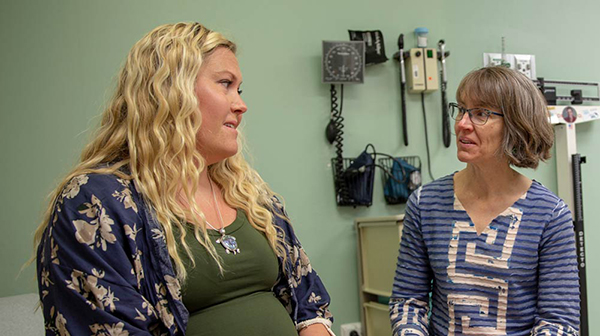
Together, the egg and sperm form a zygote—a cell containing DNA that will determine genetic characteristics such as eye and hair color. For three days, the zygote stays in the fallopian tube. It rapidly divides into more cells and enters the uterus. Once it gets there, the zygote attaches to the uterine lining (endometrium).
Three weeks after your last period, the zygote becomes a blastocyst—a ball of cells that develops into an embryo. Lots of things are happening:
- The first nerve cells start to form.
- A watertight sac grows around the embryo and fills with fluid. This is called the amniotic sac, which cushions the embryo until delivery.
- The placenta starts growing. This flat, round organ will give the embryo nutrients and oxygen.
By the fourth week, the embryo is the size of a grain of rice. Its blood circulates and its heart begins to beat.
Your Body:
You'll likely feel breast tenderness or light abdominal cramping. Many women also have a bit of spotting, but not a full period. This makes it tricky for some women to be sure whether they've missed a period.
If you take a home pregnancy test and it is positive, call your doctor or midwife to schedule a visit. We can use blood and urine tests to confirm whether you are pregnant. If you are pregnant and want to keep it, the first prenatal visit will be around weeks 7 or 8 of pregnancy.
Prenatal Care:
In the first month, your doctor or midwife won't be highly involved until your first prenatal visit. However, if you are seeking treatment for subfertility or infertility, we will likely see you sooner.
Month 2
Week: 5-8
Pregnancy:
By month two, the facial features, digestive tract and sensory organs start to develop. So do buds for arms, legs, fingers and toes. Bones begin to replace cartilage. The neural tube (the brain and spinal cord) also starts to evolve.
The head will be larger than the rest of its body. Don’t worry—this is normal! You'll be able to hear the heartbeat on ultrasound between six and eight weeks.
Toward the end of the eighth week, the embryo will be called a fetus. It will be about the size of a raspberry.
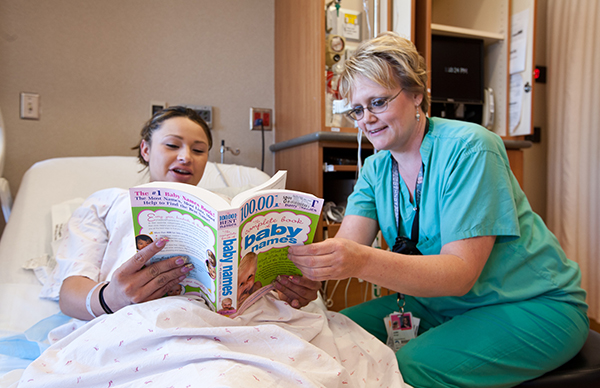
Your Body:
The second month is when pregnancy symptoms such as morning sickness, food cravings, low sex drive and exhaustion kick in. To cope with nausea, we recommend small meals throughout the day. When you wake up, eat a little bit of protein and avoid spicy, greasy foods. Other helpful remedies include ginger or acupressure bands.
To get better sleep, try Unisom, an over-the-counter combination of vitamin B-6 and doxylamine sold over the counter.
Many patients feel like they need to pee more than usual. That's because a hormone produced by the placenta—human chorionic gonadotropin hormone (HCG)—also tells your kidneys to work harder. Your growing uterus also starts to press on your bladder.
Headaches are common early in pregnancy. To help, you can take Tylenol, drink lots of water and have a bit of caffeine. Severe or frequent headaches can be a sign of serious illness. Talk with your healthcare provider about your headaches.
Prenatal Care:
Around week six, women typically decide where to get prenatal care. If you plan to deliver at the UNM Hospital, consider prenatal care here, too. You'll get to know the care team, and we'll have your medical records at hand when it's time to deliver.
Your first prenatal visit will be a longer, in-depth appointment. We'll do lab work, ask health questions and do an ultrasound to help confirm your due date. Find out what to expect at your first prenatal visit.
UNM Hospital is certified as baby-friendly by the World Health Organization. We help new moms implement the 10 steps to successful breastfeeding. At your very first visit, we will start discussing breastfeeding and its benefits. No matter what you, we will support you.
Month 3
Weeks: 9-12
Pregnancy:
The arms, hands, fingers and toes are formed by month three. The fetus starts to explore its environment by opening and closing its hands and mouth. Teeth and ears also begin to form at this time.
Though we won’t know the gender until around week 20, reproductive organs are already forming. By the end of the first trimester, the formation of the fetus has finished, but with lots of growing left to do.
By the end of 12 weeks, the risk of miscarriage decreases drastically. At this point, the fetus is the size of a plum.
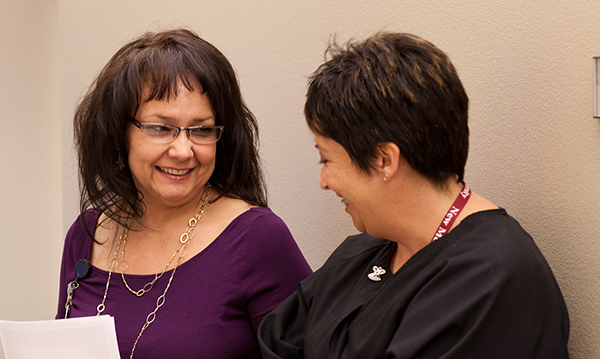
Your Body:
Pregnancy symptoms may be in full swing. You may experience new symptoms such as constipation, acne, and enlarged, tender breasts. Some women bypass these symptoms and get a pregnancy "glow" instead.
From weeks 10 to 12, you will start to feel full faster. Your uterus will start to push out over your pubic bone. Some women experience round ligament pain—stretching and pulling on the sides of the belly. Your blood volume also begins to increase, and you appear larger than usual.
You may have an increased amount of clear vaginal discharge called leukorrhea. In most cases, this is normal and healthy. However, you are welcome to call your provider if you are worried.
Prenatal Care:
We will only recommend a pelvic exam if there is a reason. If you are due for a Pap smear, that test is safe during pregnancy. We'll also double-check your due date at this time.
Around three months, you may choose to get genetic screening tests. These tests tell us whether the fetus may be at increased risk for genetic conditions such as Down syndrome or trisomy 18.
Depending on your age and medical history, we may offer:
- Non-invasive prenatal testing
- Amniocentesis (testing a sample from the bag of waters)
- Ultrasound
- A combination of these
Trimester 2
Month 4
Weeks: 13-16
Many women say the second trimester is the most comfortable stretch of pregnancy.
Pregnancy:
The fetus's bones are hardening and becoming denser. Its nervous system function is improving, and genitalia is forming. Fingers, toes, eyebrows and eyelashes are well-defined.
The fetus can suck its thumb and make facial expressions. At the end of week 16, it's the size of an avocado.

Your Body:
Nausea and vomiting should resolve, leaving you with more energy and potentially a higher sex drive. Some women start to feel more attached to the pregnancy as their body changes. It doesn’t stop there.
Hormone shifts will change your blood flow and volume. Some women experience lower blood pressure, causing a bit of dizziness throughout the day. You may also have a stuffy nose, leg cramps and sensitive gums.
You may start to see dark spots on your skin, especially on the face, called the mask of pregnancy (melasma). This is normal. Spots may also appear on your nipples, inner thighs, armpits and stomach. Spots often go away after pregnancy, but some may be permanent.
Prenatal Care:
You may choose to get multiple marker screening, a genetic screening test that uses a blood sample without ultrasound. UNM Hospital offers the test at 15-21 weeks. At your visits, we will start discussing mood and mental health during and after pregnancy.
The “baby blues”—feeling sad or emotional—are common after delivery. Approximately one in eight patients experience symptoms of postpartum depression (PPD). This serious mental health condition can cause women to harm themselves or their babies. Help is available.
We screen all pregnant patients and new moms for depression and anxiety. UNM Hospital offers the Rose Program, four classes for anyone who wants to learn about PPD risks and symptoms. Attendees learn how to identify signs of PPD and how to get help for themselves or a loved one.
Private, respectful mood care for new moms is available at the UNM Hospital Journeys Clinic. The Journey’s Clinic offers depression therapy and medication as needed for up to a year after giving birth.
Month 5
Weeks: 17-20
Pregnancy:
The fetus starts developing and exercising its muscles. You might feel its first wiggles and kicks, called quickening. Hair grows not only on the fetus’ head, but there's also a fine, soft layer of body hair called lanugo. A thin, white, cheese-like substance called vernix coats the fetus to insulate it from the amniotic fluid.
At the end of week 20, the fetus is the size of a banana. It will weigh between half a pound and 1 pound.
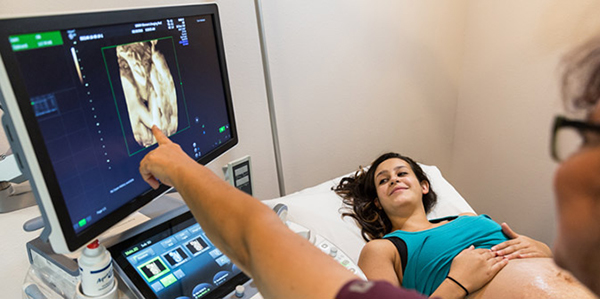
Your Body:
As your uterus expands to the top of your belly button, you may experience more backaches. You'll also start to look more pregnant. Some women experience heartburn in the second trimester.
Not only is your belly growing, but so are your breasts. You might also have a fuzzy memory. We call this pregnancy brain.
Usually, around 20 weeks, stretch marks may start to form on your breasts, belly and other areas where the skin stretches. Often, stretch marks remain after delivery. For many women, the marks fade to a lighter color. If this bothers you, keep your skin well-hydrated with lotion during pregnancy.
Your weight will also increase. Continued struggles with constipation are common and can cause some patients to develop hemorrhoids
Prenatal Care:
You'll get a fetal anatomy ultrasound at 20 weeks. You'll get to see how the fetus is growing, where the placenta is and whether the cervix is closed. You may even get to find out the gender if you want.
If the fetus looks healthy and your pregnancy is low risk, this will be the last ultrasound of your pregnancy. However, if you or the fetus have or are at risk for health conditions, you may need more ultrasounds.
Month 6
Weeks: 21-24
Pregnancy:
By month six, the skin is starting to develop. Veins are visible, and the skin has a reddish hue. Finger and toe prints have developed. At 24 weeks, the pregnancy has reached viability. If you go into labor early, the baby has a chance of survival. The longer the baby stays inside, the better.
At the end of month six, the fetus is the size of an ear of corn. It weighs approximately two pounds.
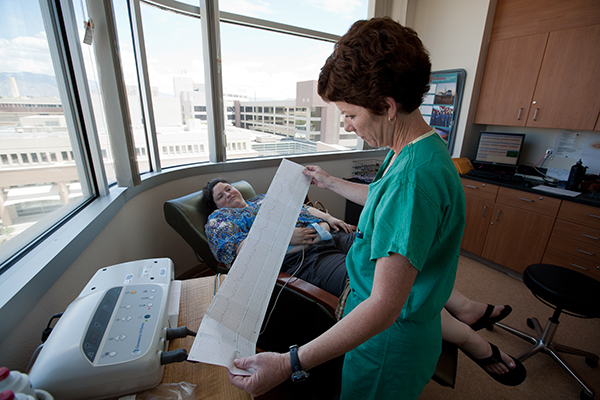
Your Body:
As the fetus grows, your uterus will start to put pressure on the lungs. This can cause shortness of breath. All the stretching can cause dry, irritated skin around the stomach. Your belly button may pop out, becoming an "outty." After delivery, it will return to its normal shape.
Tingling in the hands and feet and bleeding gums are common symptoms. Your sex drive may fluctuate higher or lower—either is normal.
Prenatal Care:
At six months, we start measuring the uterus by checking the size of your belly from the top of the uterus to the pubic bone. This is another way to check the pregnancy progress.
Between 24 and 26 weeks, you'll do the next big test—the glucose screening for gestational diabetes. In the U.S., about 6% to 9% of pregnant patients develop diabetes during pregnancy. Unmanaged diabetes can increase the risk of birth defects and preterm birth. So, this test gives us information to help get your blood sugar under control.
You can also sign up for home visits through our Nurse Family Partnership program. A nurse can visit you at home to help with pregnancy questions through your child's second birthday. Talk with your provider to sign up before the end of the second trimester.
Trimester 3
Month 7
Weeks: 25-28
The home stretch of pregnancy.
Pregnancy:
Starting around month seven, the fetus can change positions in your belly. It will be gaining fat to use for energy. The fetus can now hear noises outside the belly. If the baby is born during this time, its chances of survival are greater, thanks to advances in neonatal intensive care.
At the end of month seven, the fetus is the size of an eggplant. It weighs 2-4 pounds.
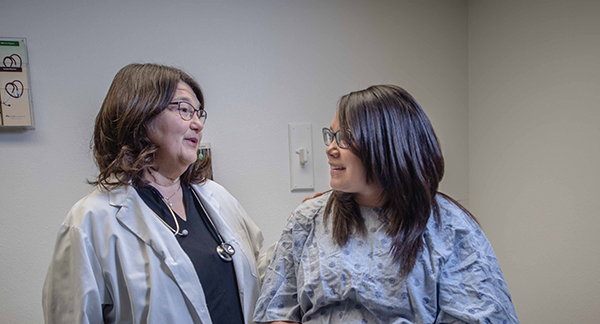
Your Body:
This is the point where you may feel like you’ll be pregnant forever! You will start to feel increased fluid retention and swelling. This can cause tingling in your hands.
During the day, your belly may feel heavy. Wearing a belly support band can help. At this stage, you notice your first breastmilk (colostrum) leaking from your nipples. It may be yellow-tinted. Nutrient-rich colostrum is sometimes called liquid gold because it's so healthy for newborns.
At night, you may have trouble sleeping— getting comfortable is tough, plus you may need to use the restroom frequently. Try propping up your legs or belly with pillows for more support or taking Unisom as directed for better sleep better.
Prenatal Care:
If your glucose screening showed high blood sugar, you may need another screening to determine if you have gestational diabetes. If you do, a certified Diabetes Educator will meet with you for regular blood sugar checks and guidance about diet and exercise.
You'll also get a complete blood count test (CBC) to check for iron-deficiency anemia, affecting 15-25% of all pregnancies, causing dizziness and fatigue. If diagnosed, we will recommend iron therapy.
At week 28, we'll start seeing you every two weeks. We'll test you for a blood protein called Rh. If you do not have Rh in your blood, you will need a medication called RhoGAM. This medicine protects your baby during delivery, where your blood might mix with theirs.
Month 8
Weeks: 29-34
Pregnancy:
By month eight, you will know exactly what your baby’s kicks feel like. You might feel like a punching bag! There is a lot of development happening, especially in their brain. However, the lungs are still immature.
By the end of week 24, the baby will be the size of butternut squash. It weighs about five pounds.
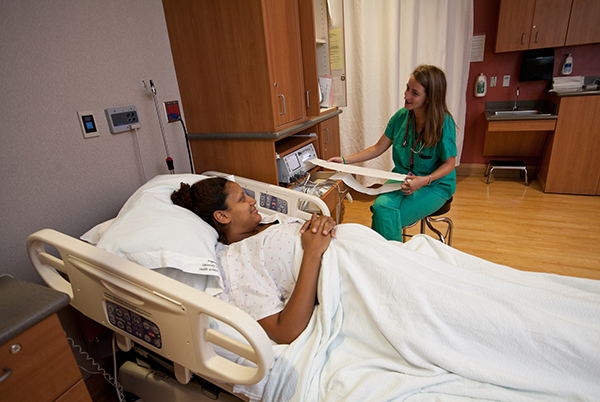
Your Body:
Only a couple more weeks of itching, swelling and heartburn to go! Many women also experience tender breasts and more frequent urination.
Around 30 weeks, some women feel practice contractions, known as Braxton Hicks contractions. The belly will tighten and harden for a moment, then relax. These should not be painful. If you are concerned, call your prenatal care provider.
Prenatal Care:
In month eight, we'll see you every two weeks to discuss your health, pregnancy and childbirth education. UNM Hospital offers a two-part weekly class on Saturdays to learn more about your pregnancy, labor and newborn care. During the pandemic, the class is online. Watch these videos to learn more.
We'll also talk about your options to manage labor pain, along with other aspects of your birth plan. Here, we'll prescribe you a breast pump to get used to working with. And, while it might seem early, we'll discuss birth control options to help you plan for after the baby comes.
Month 9 and Beyond
Weeks: 39-Delivery
Pregnancy:
After 38 weeks, the baby is almost fully developed. Delivery after 38 weeks is generally considered safe. But the closer to the due date, the better since the brain is continuing to develop.
At this time, the baby is the size of a watermelon. It weighs around 7 pounds.
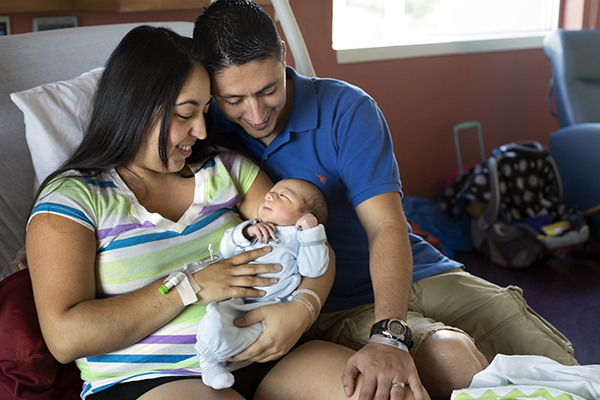
Your Body:
Between 36 and 40 weeks, you'll feel the baby drop low into your pelvis. This is called lightening or engagement. You should be able to breathe and eat easier, but you may feel more pelvic pressure.
The baby should be head down, with its rump pointed toward your lungs. In 3% to 4% of pregnancies, the baby is breech—bottom down instead of head down. In some cases, this may mean you will need a cesarean section. But sometimes, the baby turns around on its own.
Braxton Hicks contractions will become more regular and noticeable. Around 37 or 38 weeks, some women lose their mucus plug—the cap that closes off the cervix from the vagina. This is not the same as your water breaking, which will be a trickle or gush of fluid out of your vagina. If your water breaks, call your provider right away—labor should begin soon.
Prenatal Care:
At 35 weeks, we'll start seeing you weekly. We'll coach you about what to expect during labor and delivery. Childbirth can be unpredictable, so we will discuss what happens if your birth plan has to change or if you need a C-section.
If you live far away from UNM Hospital, you might consider staying close by for a few weeks. This is especially important if this is your second pregnancy. Often, the second labor goes faster than the first. We'll also introduce you to other midwives and providers who might be on call when you give birth. Watch our Meet the Midwives video.
During this time, it's important to get help lined up at home. If possible, ask family or friends to help with meals, cleaning and caring for older children so you can rest and bond with the new baby. Your prenatal care provider can help connect you with resources and support in your community.
Each month of pregnancy brings new developments. A lot happens in the 40 weeks between conception and delivery! All the changes can feel overwhelming at times. Your OB/Gyn or midwife will be there for you from the first visit through delivery and beyond.

